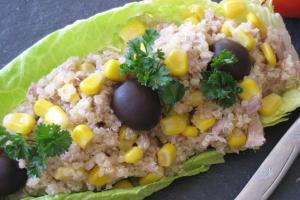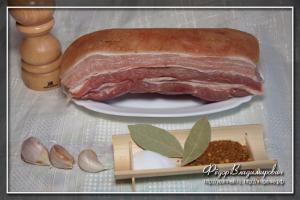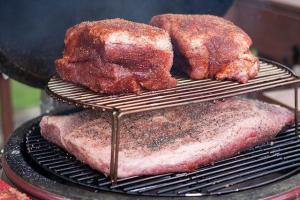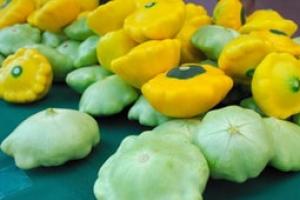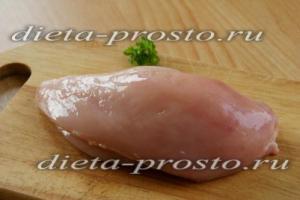Groundnuts, or peanuts, are a member of the legume family. It belongs to those few plants whose fruits develop and grow underground. It is considered a valuable oilseed crop and is widely used in the food industry.
By appearance peanuts resemble pods from 1 to 6 cm long. The number of yellowish seeds contained in them is usually from 1 to 3, the maximum can reach 6 pieces. The seed coat takes on different shades: dark purple, red, pink or variegated.
As a result of pollination of flowers and subsequent fertilization, the lower part of the ovary grows. It forms a gynophore - a shoot that penetrates the moist layers of the soil and forms a fruit. If the flowers are located at a height of more than 20 cm from the ground, then they have no chance of forming seeds.
Translated from Greek, peanut means spider. The plant owes its name to the resemblance of the mesh pattern on the surface of the pod to a spider's web. A Due to the way the fruit ripens, peanuts are often called groundnuts.
South America is considered the historical homeland of this valuable product. It was from there that he began his journey around the world. At the beginning of the 16th century, the Portuguese introduced peanut seeds to India, the colony of Macau and Japan. The nut came to the Philippines and Madagascar from Spain.
At the end of the 16th century, Portugal founded a colony in Canton. The plant ended up in China, where local residents appreciated it. Peanuts helped solve the problem of hunger in the country and were called Chinese nuts.
The next destination was Africa, where it took root well on almost infertile soils. The area under peanuts grew rapidly, and the oilseed crop began to be grown for export.
Mass distribution of nuts in the USA began in the 19th century after Civil War 1861. On the advice of the American agricultural chemist George Carver, farmers alternated crops of peanuts and cotton, which were increasingly dying due to damage by the cotton weevil. Soon, nut yields exceeded the income from cotton many times over and became the main crop in the southern United States.
D. Carver has developed hundreds of varieties of products and products from the plant. Peanuts are included in drinks, dyes, cosmetics, medications.
Russia was able to appreciate all the benefits of culture at the turn of the 18th-19th centuries. The most suitable climatic conditions for growing groundnuts are located in the Transcaucasus, Central Asian republics, in the southern part of Ukraine, and in the North Caucasus.
Calorie content and vitamin composition
Peanuts are high in calories: 100 g of product contains 551 kcal. People prone to obesity are not recommended to indulge in nuts, especially fried ones.

Despite the fact that peanuts belong to the legume family, their content useful substances and vitamins it is closest to nuts.
Chemical composition includes:
- essential nutrients– proteins (26.3 g/100 g), fats (45.2 g/100 g), carbohydrates (9.9 g/100 g);
- cellulose, sugar, starch;
- vitamin complex(B, C, E, RR);
- micro- and macroelements– phosphorus, zinc, iron, copper, calcium, magnesium, manganese, potassium, sodium, selenium.
Useful properties and disadvantages
Experts who studied the properties of peanuts came to the conclusion that the benefits and harms of the product are approximately the same. If you take into account contraindications for use and observe the measure, then unpleasant consequences can be avoided.
The beneficial qualities of groundnuts are as follows:
- Proteins and fats contained in peanuts are easily absorbed by the body. The rich vitamin and elemental composition puts the nut on a par with products recommended for a healthy diet.
- Presence of linoleic acid reduces the risk of developing sclerosis. With sufficient content of this important component in the body, the synthesis of essential fatty acids - linolenic and arachidonic acids - occurs. They help maintain normal blood cholesterol levels.
- Peanuts help improve blood clotting, which reduces blood loss in wounds and in patients with hemophilia.
- Because of high content antioxidants, the nut (especially roasted) is a useful preventive measure for heart and vascular diseases. Slows down the aging process and division of cancer cells.
- Natural fiber from peanuts helps improve digestion, removing pathogenic bacteria from the body.
- Amino acid found in peanuts tryptophan produces the hormone serotonin in the body. Its increased content brings people out of depression, restores nervous system after stress.
- Possesses choleretic effect.
- Is a good helper in the fight against infections, improves immunity.
- With constant consumption of fruits in small quantities, people experienced improved hearing, memory, concentration of attention increased.
Products made from nuts have almost the same beneficial qualities:
- peanut butter preserves a complex of essential vitamins and elements;
- peanut milk has a positive effect on the gastrointestinal tract;
- peanut paste provides the body with energy.

Walnut harm:
- Seed coat may cause allergic reactions, usually expressed by itching and redness of the skin. In rare cases, vomiting and laryngeal swelling are possible.
- For joint diseases Consumption of foods high in protein is contraindicated.
- If the technology of seed processing, transportation or storage has been violated, nuts can accumulate toxins. Therefore, when purchasing, you must make sure that there is no mold on the shell. Foreign odor is also unacceptable.
- People suffering from varicose veins should not eat peanuts due to their ability to thicken blood.
The famous peanut diet raises many questions. On the one hand, the nut promotes the rapid breakdown of fats. On the other side of the scale is the high calorie content of the product.
The decision to use peanuts for preventive purposes or to treat any disease should be made only after consulting a doctor. It is necessary to strictly adhere to the recommendations of specialists. Abuse of any product can cause irreparable harm to the body.
Peanut uses
The taste of nuts is familiar to everyone. Fried, salty, sweet, honey-sesame - they can be purchased at any store. Crushed peanuts are used in various baked goods., chocolate spreads, halva, creams, coffee drinks.
Most of the harvest is processed for the production of vegetable oil. The highest grade is used in canning and confectionery production. Low grades of peanut oil are used to make high quality Marseille soap.
Protein from nut seeds is integral part various types of glue, plastic. It is used in the production of vegetable wool - ardila.
The tops of the plant are used to feed cattle.
An interesting fact: in the USA, peanuts are even contained in dynamite; in Russia, this function is performed by soybeans.
Growing technology
To grow a truly high-quality product and reap a rich harvest, you need to strictly follow the recommendations:

- Pre-sowing tillage fertilizers can double the yield. Peanuts need to grow good lighting and warm soil. Optimal temperature for seed germination 25-300C. The lower limit at which their germination is still possible is not lower than 140C.
Soil moisture plays a big role in crop growth, especially during flowering. The main thing is not to overdo it with watering. Stagnation of water will adversely affect the harvest - rotting of the roots and the appearance of spots on the leaves will lead to the death of the plant.
- It is best to plant in early June. At this time, the risk of frost on the soil is minimal. Dried seeds and beans are used for sowing. Gardeners recommend choosing large seeds, otherwise you may not wait for germination.
- Place 3-6 pieces of nuts in a hole 7-10 cm deep (sometimes a little more), the distance between the sowing rows is left at least a meter. On moist soils, sow peeled seeds 3 cm from the surface.
Given that the nut ripens underground, it is difficult to establish an exact harvest date. On average it is 3-4 months for early varieties and up to six months for later ones. You can assess the degree of their readiness by tasting a few pieces.
Harvesting peanuts in dry weather. The bushes should be easily pulled out of the ground. When frosts begin on the ground, most of crops are at risk of remaining underground.
The beans are then dried in the sun for several weeks and taken away for storage or processing.
Rules of care
For getting good harvest The seedlings need to be looked after.
- To create the required humidity peanut water every 2 weeks. In dry times, this period is halved. Watering is stopped 3-4 weeks before harvest.
Cannot be used for watering bushes cold water, especially in hot weather.
- After the appearance of inflorescences, carry out regular hilling of bushes.
- Mandatory weeding.
- Fertilizer application at least 3 times during the ripening period. Fertilizing can significantly increase yield by reducing the number of underdeveloped beans.

Conclusion
Peanuts are a unique crop. As a representative leguminous plants, it ripens in the ground like potatoes. Has many benefits as a preventive and therapeutic agent. And the wide range of applications of nuts in various types industry makes it a universal product.
Groundnuts (peanuts) are a tasty and at the same time healthy food, which contains a large complex of elements important for the body. This plant is quite unpretentious, but few people know how to grow peanuts and provide them with proper care.
Optimal timing for planting
Experienced agronomists are confident that the most suitable time to plant peanuts in open ground is May: at this time the soil has already warmed up enough and will not harm the seeds. However, you should still focus on the growing region. If in your area they occur even in late spring, it is better to postpone planting to early summer. 
Selecting a location
Before planting peanuts, you need to select them a good place on and create optimal conditions for it there.
When choosing a location, it is important to consider that photophilous plant, however, he also takes light shading calmly. For planting, it is extremely important to get rid of snow and dry out as quickly as possible. Cold winds have a negative impact on yields.
Did you know? Peanuts first came to us in 1792, they were brought from Turkey. Today this plant is grown on a large scale in China, India, Nigeria, and Indonesia.
Lighting
Peanuts love light and warmth. Even the slightest shading will lead to rapid plant growth, slower development of vegetative organs, and a reduction in the number of fruits. The need for warmth remains throughout.
The soil
Since the peanut fruit grows directly in the plant, its quality and texture are of key importance. This plant needs s neutral pH, which is rich in calcium and magnesium. Perfect option- light and maximally loose, which allows air and water to pass through well. In addition, it should contain some amount of sand. Before planting, the soil must be enriched. 
Predecessors
To obtain a good harvest, plants that previously grew on this land play an important role. Peanuts will develop best after, and. But, on the contrary, they can lead to the development of rot on the roots, so it is better to refrain from planting peanuts in their place.
Preparing the site before planting
Basic soil preparation is layer-by-layer stubble peeling, which will allow for maximum removal, and raising the plowed land to a depth of 30 cm. The first work is carried out immediately after harvesting the predecessors, the depth of the first treatment is 6 cm, the second is deeper: 11 cm.
In early spring, harrowing is carried out transversely or diagonally. Early treatment is carried out during the emergence of annuals. Cultivation should be carried out only on dry soil; it is recommended to do this 30 minutes before sowing.
Peanut sowing pattern and depth
Planting peanuts in open ground is best done using the square-nest method. The most commonly used scheme 60 × 60 cm, however, no one prohibits planting in other ways, for example, wide-row, when the width between rows is 65 cm and the distance between plants is 20 cm.  To obtain good seedlings, use only large seeds, which are planted to a depth of 7 cm. It is recommended to place at least three seeds in each hole.
To obtain good seedlings, use only large seeds, which are planted to a depth of 7 cm. It is recommended to place at least three seeds in each hole.
Complete the planting with abundant. The water pressure should be low so as not to wash away or expose the seeds. It is better to repeat the manipulations several times until puddles appear.
Care and cultivation techniques
The main agrotechnical techniques for successful cultivation of peanuts are fertilizing, hilling and loosening. Of course, we should not forget about plant protection and prevention.
Watering, weeding and loosening
On average, the need for batteries by development phase is as follows:
- shoots before the appearance of three leaves - phosphorus;
- branching - and ;
- the appearance of buds - nitrogen;
- flowering period - phosphorus;
- legume formation - nitrogen and potassium.
Hilling up bushes
Throughout the growing season, peanuts are earthed approximately five times. The correctness and frequency of execution directly affects the yield. The first time such work is carried out is on the tenth day after the end of the flowering period, when the fruit-bearing shoots descend into the ground.
Before creating a sufficiently high hill (6 cm), it is recommended to water the soil thoroughly. This will increase the number of tiers in which the future harvest. Subsequently, hilling is carried out every 10 days. 
Pest and disease control
To avoid damage by cercospora, you need to monitor and isolate new crops from last year's. If this does not help, it is recommended to treat the area with a 1% solution or available substitutes. To prevent plants from getting sick with Fusarium wilt, you need to include crops in your crop rotation.
Peanuts can suffer from Alternaria, phyllosticosis and gray rot. Get rid of these problems using resolved processing. Against
When tending to their own garden at the dacha or in a private home, some people ask themselves the question: “What should I plant?” Indeed, with such a variety of options, it is difficult to choose just one. What about peanuts? You can grow it yourself, reap an impressive harvest and enjoy the fruits of your labors for a whole year until a new peanut grows. It's not difficult to do this. Peanuts are not fussy in terms of care and planting features. But certain nuances are worth knowing.

Why is it worth growing it?
If you don't take into account useful qualities peanuts, there are many more reasons why you should try to grow them on your plot:
- This is a tasty product;
- You don’t have to buy peanuts in stores and spend a lot of money;
- Peanuts are an important ingredient in many dishes, desserts, and baked goods;
- You can make your own peanut butter for yourself and your children. This is an incredibly tasty delicacy;
- By cold pressing you can get vegetable oil, which is in many ways superior to sunflower. It does not burn, does not smoke, and does not absorb the odors of foods that are fried on it. This oil is great for making French fries.


What is the value of peanuts, and why exactly can they become great solution to fill your vegetable garden:
- Nuts contain a large number of vitamins, minerals, microelements that have a positive effect on our body.
- The fats it contains are high quality and therefore healthy.
- According to research, peanuts contain antioxidants. And this is a means to combat cancer, atherosclerosis, premature aging of the body, and so on.
- Peanuts do not take away strength from the soil, but on the contrary, enrich it. So, after planting nuts, even capricious crops that are demanding on the quality and fertility of the soil can be grown in this place.
Of course, you should not use it if you are allergic. At overweight Limit yourself to peanuts, do not overuse them. A moderate amount of nuts will provide the body with the necessary benefits and avoid harmful effects.
How to grow at home
For planting, you can use the same nuts that are sold in stores. But not in bags with salt and other seasonings. Take shelled or even shelled peanuts, what else? better than the first option.
Soak them in water, place them on a damp cloth and wait for the sprouts to appear. After they appear, you can begin planting them in the ground. Moreover, this can be either a summer cottage garden plot or a pot on the windowsill or on the balcony.
The most important thing is that the soil is loose with a portion of sand. The plant loves warmth, so grow it in a well-lit area.
The period of active development begins in the summer. So it’s better to soak the nuts in April and plant them in the spring. By autumn you will be able to harvest.

Growing methods
In general, this crop can be grown in two different ways.
Seedlings
Take a container where the seedlings will be placed. Choose light, soft and loose soils. Seedlings begin to grow in April. Place a nut in a glass with soil (in shell is better) and water moderately. Already in the first days of summer, seedlings will appear, which can be transplanted into the garden from the beginning of June. Prepare the soil in advance so that there are no weeds there. Loosen it properly. The softer the soil, the easier it is for peanuts to be absorbed into it. Planting is carried out in rows with an interval of 15-20 centimeters. Maintain a distance between rows of about 50-80 centimeters.

Open way
To effectively grow peanuts using this method, you need to have high-quality soil at your disposal. After all, peanuts “burrow” into the ground and ripen there. So clay soils are not suitable. As soon as the air temperature reaches 20 degrees, you can plant nuts in the ground. That is, landing occurs approximately from mid-May. Planting is similar to planting seedlings. Try to protect the first shoots, as birds love them very much.

In greenhouses
The easiest way to maintain temperature and moisture is to grow this crop in greenhouses, that is, greenhouses.
It is best to place peanuts in close proximity to the tomatoes and the walls of the structure
Trim the bottom leaves of the tomato to give the peanuts the space they need. Tomatoes should be tied up and not grown on the ground. Peanuts, in turn, will provide tomatoes with vital nitrogen due to nodule bacteria.
Under such conditions, the nuts will develop rapidly. You will not have to hill up as often, and by autumn you will get a magnificent harvest.

Seeds
As you already understand, you can’t do without the nuts themselves for planting. Therefore, you need to select good seeds that will provide an appropriate harvest.
Any raw peanuts will do. You won't be able to grow anything from nuts packaged with salt or other seasonings.
It's even better if the peanuts are in hard shells. Then the chances of successful cultivation increase.
But the seeds are not simply buried in the ground after purchase. Take the amount of nuts you need, wet them a little, and place them on a damp cloth. After a few days, the nuts should swell and sprouts will appear. Throw away those nuts where these processes have not occurred. They are not suitable for landing.
Of course, the easiest and most correct way is to purchase seeds at a garden store. But you can’t always find them there.

Peculiarities
There are several nuances that you should pay attention to when growing peanuts:
- This unpretentious culture who loves warmth. Therefore, the nut will develop when the temperature reaches 20 degrees or more. When the temperature drops below 15 degrees Celsius, growth stops. Therefore, it cannot be grown in all regions.
- If climatic conditions are close to optimal, but the soil does not warm up in any way, use films or agrofibre.
- For higher yields, first plant the seeds in the ground in April. plastic cup. By summer, seedlings will appear. In early June, when it has already become quite warm, you can safely transplant the seeds into the garden.
- Remember, peanuts only bloom for a day. That is, the flowers will bloom in the morning and wither in the evening. During this period, the peanuts have time to pollinate. After this, the sprouts cut into the ground, climb to the depths and there develop into the state of fruits, which we all know as peanuts.
- During the beginning of flowering and in the active flowering phase, the plant is watered abundantly. Then you don’t need much water anymore. Moisten the soil if drought lasts more than a few days.
- Protect the seedlings from birds, as they can destroy your crop.

Care
Having planted nuts, all that remains is to care for them and wait until they ripen. During this period you must:
- Water and loosen the soil, do not over-moisten the soil except during flowering and setting. During these periods there should be a lot of water.
- Carry out weeding every time after it has rained or you have watered the peanuts yourself.
- Hill up the ovaries like potatoes.
- Add mineral fertilizers three times during the season. The first time during the formation of leaves, the second - when the buds bloom, the third - during the ovary.
- Peanuts are not particularly friendly with caterpillars, aphids, root and fungal rot, as well as other pests. Control methods are the same as when growing other crops belonging to the legume family.

Did you know that when you eat peanuts, you are consuming close relatives of beans and soybeans? Did you know that peanuts do not grow in the ground, as many people believe, but on trees? If you know, then it’s true that nothing will surprise you. But wait! You will certainly be surprised by peanuts in an ordinary pot, grown in the form.
How to grow peanuts at home
Today we'll talk about...
If you are reading this, it means that you are interested in whether you can plant the seeds of this plant and whether they will germinate. We have good news for you - peanuts can grow not only in open ground, but also in pots for indoor plants, so everything should work out for you. Start by buying nuts, giving preference to those with shells rather than shelled ones. If you plant unshelled peanuts, it is believed that they will grow more actively, receiving all the necessary nutrients from the peel. Also, in the store, pay attention to the freshness of the nuts and their appearance - if they are covered with mold, then they can hardly be planted.
You can use small ones for sowing peat cups in which seedlings are grown. To lighten the soil and improve its moisture-repellent characteristics, add some river sand and peat.
Note! Be sure to soak the seeds before planting. Use a damp cloth for this.

Open the peanut flap so that the nuts are halfway inside. Moisten the soil before planting using a weak solution of potassium permanganate. In each pot, place one open flap with several nuts in it, sprinkle with soil. After this, fill the pot warm water. You can purchase gardening products on our partners’ websites.

Place the pots in a warm place, you can put them on the windowsill next to the radiator - this way the seeds will sprout faster. In about two weeks the first shoots should appear; you can transplant them “permanently”. For this, take a wide container with a depth of at least 30 centimeters, since the nuts will ripen in the ground, and the roots, as you know, need space to develop. Place drainage at the bottom of the container and cover with loose soil.
Note! Relocate bushes with lumps of soil so as not to damage the leaves and roots!
Then compact the soil a little at the base of the plant and fill it with a heated solution with a root formation stimulator. If you don’t have such a stimulant at hand, then use a plant-based biostimulator - aloe. Squeeze the juice from one leaf directly into the water intended for irrigation. Cover the container plastic bag for seven days, ventilate it every day. These simple manipulations will help the bushes take root faster. After a week, remove the film and place the containers closer to the light, but Avoid exposure to direct sunlight! Water and loosen the soil regularly - peanuts cannot tolerate dry conditions and their growth slows down in such conditions. Feed it weekly with mineral fertilizers.
 Peanuts grow quickly and should bloom as early as June. Bright yellow flowers will appear, but only for one day - after that they will fade and be replaced by “fresh” ones. Two to three hours of such flowering is enough for the pollen to ripen and the plant to be pollinated. Soon the stalk of the pollinated ovary will begin to lengthen and gradually bend towards the ground until it penetrates into it.
Peanuts grow quickly and should bloom as early as June. Bright yellow flowers will appear, but only for one day - after that they will fade and be replaced by “fresh” ones. Two to three hours of such flowering is enough for the pollen to ripen and the plant to be pollinated. Soon the stalk of the pollinated ovary will begin to lengthen and gradually bend towards the ground until it penetrates into it.
After falling into the ground, the young fruit is located there in a horizontal position. Ripening occurs in the ground at a depth of approximately 10 centimeters. There the fruit turns into a five-centimeter bean, consisting of several nuts.
Note! Around September, stop fertilizing and reduce the frequency of watering - this will allow the nuts to develop better in the soil.
Soon the leaves will turn yellow, which will indicate the end of ripening. After the leaves become completely yellow, carefully pull the bushes out of the ground. If you grew peanuts at home That’s right, then on each bush you will have fifteen to twenty beans with nuts.
After digging, place the bushes on thick paper and leave for several days to dry - this will prevent the formation of mold. As a result, the beans should be easily separated from the branches. Peel the collected nuts and place them on thick paper, dry for several days, stirring occasionally.

And remember: peanuts are an annual plant. If everything went well, you can try next year grow peanuts at home already in open ground. Many gardeners do this, so why not try it too?
As a rare annual plant Peanuts are now found in different climatic regions of the planet. Despite the fact that its homeland is the warm climate of South America, where wild species are perennials. Even if climatic conditions do not allow this plant to be planted on large industrial plantations, curious summer residents and owners of private estates who know how to plant peanuts in open ground proudly treat their loved ones to healthy groundnuts.
Some conduct successful agrotechnical experiments in their dachas. Others use greenhouses, home greenhouses are just window sills. Curiosity and pleasure from the results of work cannot be stopped. The more advice and experience of specialists on how to plant peanuts is used, the better the result.
Agrotechnics of cultivation
Peanuts are classified as plants that love heat and light from the legume family. It develops ideally at temperatures of 25, 27 . At temperatures below 15, a warm sunny place without shade, good ventilation, and timely watering help the formation of beautiful bushes. Its small yellow flowers live one day. Formed due to pollination, the ovaries sink into the ground, where they turn into useful groundnuts. Flowers remaining on the surface die and do not take part in the formation of the crop. Therefore, it is very important to know how to plant peanuts in the garden, keep the soil in a breathable, loose state, and carry out hilling several times like a potato bush.
Peanut varieties
The main condition for the success of obtaining a good peanut harvest is the selection of high-quality seeds of popular varieties and compliance with important technological aspects of cultivation. The number of new varieties is growing from year to year. Each has varieties. Many have care features that depend on local conditions. The following varieties are most often planted:
- Spanish. Not very large beans are used to make sweets and butter. The bushes are low growing. The bred subspecies of Dixie Spanish, Argentine, Spanko, Shafers, Natal Spanish are distinguished by a high content of oils in the fruits.
- Runner. A variety with excellent taste and high yields. Easily heat treated before use. Main subspecies: Dixie Runner, Georgia green, AT-108, Bradford Runner.
- Virginia. The most common variety with large fruits. Most often used in the preparation of salted nuts and in confectionery. A rich harvest is formed by shoots and on bundles. The main subspecies are called Gul, Gregory, Wilson, Shulamit.
- Valencia. Large fruits, heavy stem, wide, tall bush. The beans are most often used in the preparation of boiled peanuts. There are very few small nuts.
Peanut care
To plant peanuts, beans pre-soaked in potassium permanganate or seedlings prepared in small containers are used. Small beans germinate poorly. The soil chosen is fertile, loose, permeable, and has been previously dug in the fall. Peanuts do not grow well in soils high in salt and acidity. By adding lime, chalk, and phosphogypsum, you can improve the composition of the soil allocated for planting peanuts. The plant responds well to phosphorus fertilizers. Therefore, it is recommended to apply nitrophoska in the amount of 60 g per area in the spring. square meter. Sowing is carried out at the end of May after weather conditions have stabilized and the ground temperature has reached at least 15 degrees. The holes for planting are placed at a distance of 30 cm in a checkerboard pattern. Their depth is 10 cm. Three peeled, pre-soaked nuts are placed in each hole. The distance between the rows is about 20 cm. For sowing, it is better to use unshelled beans purchased in specialized stores.

The moisture-loving plant is watered once a week throughout its growth period. The soil is kept moist without excess water. The best option Watering is considered to be irrigation, the drip method. The highest need for moisture will be at the time of flowering and ovary formation. When the stalk sinks into the ground, the plant is earthed up. The first hilling is carried out approximately three weeks after flowering to a height of 7 cm. Then this must be done again every 10 days three more times until the bush gets stronger. Some gardeners recommend carrying out the first hilling after a week of flowering. After hilling, the plant does not need watering. A month before harvesting, watering and fertilizing with mineral fertilizers are completely stopped. The soil around the bush is periodically loosened and weeded. Mineral fertilizers It is recommended to apply three times: at the formation of the first leaves, flowering, and the formation of ovaries. Birds love to eat tender seedlings. A scarecrow is installed to protect them.
The experience of specialists and their tips on how to plant peanuts in the country indicate the need to observe crop rotation. Excellent predecessors for peanuts are cabbage, cucumbers, and potatoes. It cannot be planted after legumes. On small summer cottages Covering material and greenhouses are often used to protect against possible cold snaps. Peanuts are often planted along with tomatoes along the walls of the greenhouse. The lower leaves of the tomato are cut off, giving light to the peanut bushes that are actively developing in such conditions. This proximity is beneficial for both cultures. Peanuts enrich the soil with nitrogen due to the bacteria contained in the tubers, which is beneficial for tomatoes.
A real decoration of the greenhouse, shelves, and window sills will be a peanut bush. Moreover, it is also useful. Tips on how to plant peanuts at home recommend doing it as follows. Plant the sprouted seeds in small cups. Shoots will appear in 10 days. Dry seeds may not germinate. It is recommended to soak beans at the end of April. Hardening of sprouts is often used. To do this, they are taken into a room with a lower temperature during the day. They return at night. The process lasts 10 days. After two strong leaves appear, the peanuts are transplanted into a prepared wide container. This is usually done three weeks after germination. The pot is selected so that the shoots do not hang out of it, but are kept in a straight position. The ovaries should have enough space to access the soil. You can use additional reinforcements and ensure good contact with the surface of the soil in the pot. Otherwise, agricultural methods are similar to those used in open ground. It is better to place the pot of peanuts on a sunny windowsill. The lack of lighting is compensated by using special lamps. Peanuts do not tolerate drafts.
The signal to begin harvesting is the yellowing of all leaves. Using a fork, the bushes are carefully dug up, the fruits in the mesh shell are removed from the stems, dried under canopies or in places well protected from the sun. The collection is carried out in dry weather, when the bush is easily dug up. If the ground is wet, part of the crop remains in it. After drying, the shell is removed. It breaks easily. One bush, subject to proper care, produces about 0.5 kg of groundnuts. The entire harvest must be harvested before the onset of autumn frosts. If the harvest is late, the nuts may develop an unpleasant bitterness. The beans lose their viability. They cannot be used for planting.

The plant is damaged by root and fungal rot. It suffers from the appearance of caterpillars, aphids, and insects that love legumes. Ash, tobacco, and chemicals are used to kill pests.
Useful properties, application
Peanuts have long been a favorite product in human nutrition. Despite its satiety, it is well absorbed due to its high protein content. The oil obtained from groundnuts has properties that are not inferior to the well-known product from olives. Even the shells and tops of the plant do not disappear. They are nutritious food for animals. The fruits contain vitamins, trace elements, and minerals necessary for the human body. In addition, it contains antioxidants that help fight many diseases. In terms of protein content, it is second only to soybeans. Studies have shown the ability of peanuts to improve blood clotting and strengthen the immune system. The main thing is that when using this delicacy in the form of salted nuts or a sweet addition to baked goods, do not forget about its active allergenic abilities.
In addition to the use of peanuts in technological processes pharmacology, chemical industry, for the production of cosmetics, it benefits the soil, enriching it with useful elements. After it, the soil fertility improves, which makes it possible to grow some capricious plants here.
See how to grow peanuts from seedlings




